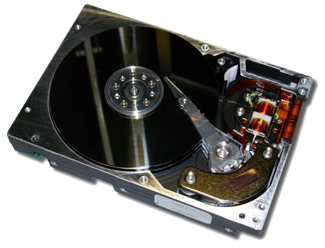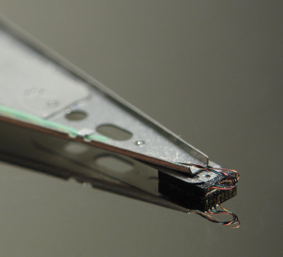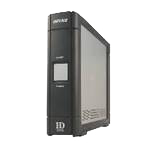Backup Strategies

As explained in
How Computers Work
it is amazing that computers work as well as they do, but they all fail eventually.
The single most important function you can perform with your computer is to backup your data.
I first learnt this lesson when I wrote programs (using BASIC code and Z80 machine code) on a Sinclair ZX Spectrum.
It took many hours cramped over the fiddly little rubberised keyboard to fill the puny 16KB (KiloBytes) of RAM (Random Access Memory),
and many more hours tweaking to make it work.
Anyone else who tried this knows that the power connector was pretty flaky,
and a single wrong move could see all your hard work consigned to the ether and the screen filled with a gaudy patchwork of digital garbage.
It wasn’t much easier playing the contents of the RAM down an audio cable into a borrowed cassette player,
but we learnt to do it every time we had something we wanted to keep.
I have not lost a single byte of data since.

There are three factors to consider when choosing a backup strategy:
-
Backup Contents
What are you going to backup - just your personal data or the entire system?
The backup contents you choose will determine the backup size and contribute to the required storage capacity.
-
Backup Timing
How often are you going to perform backups?
How long are you going to keep the backups?
Will you schedule the backup to run automatically or run it manually?
The backup frequency and duration you choose will contribute to the required storage capacity.
-
Backup Location
What backup device will you use to create the backups?
Are all the backups stored on the same media, or are there multiple media, devices or locations?
The backup media you choose determine the actual storagecapacity.
The required storage capacity is the backup size multiplied by the backup frequency and duration, as in the following equation:
(Required Storage Capacity) = (Backup Size) * (Backup Frequency) * (Backup Duration)
In practice, you will need some spare capacity on your storage media, so:
(Actual Storage Capacity) > (Backup Size) * (Backup Frequency) * (Backup Duration)
So, for example,
if you want to backup 100MB (MegaBytes) of data every day and keep each backup for a week,
you will need at least 700MB of storage capacity:
(Required Storage Capacity) = (100MB/backup) * (1 backup/day) * (7 days) = 700MB
Backup Contents

The primary aim of a backup is to restore all of the chosen systems and data to their original state and function as quickly as possible after a failure.
In the case of a mobile telephone this is quite easy -
you can just have a spare phone and a copy of your SIM (the memory card).
With a personal computer it is a bit more complicated:
Documents
The most important thing to backup is your documents -
they have been created (or collected) by you and it would probably take a long time to rebuild them by hand.
Most of these files will be found in one of several standard locations
(the My Documents folder and the Desktop).
You might also want to backup your emails, photographs, music and various other program data and settings.
It can get complicated and there is always the risk that you have missed something important.
All Files
It is much simpler to backup all of the files on your hard disk drive
(usually the C: drive, but you might have multiple hard disk drives).
Of course this takes up more space and might influence the backup timing and location
(you might need to backup less often,
keep backups for a shorter time,
or use more and larger media for backup storage).
System State
Some files on your hard disk drive cannot be copied while the computer is running because they are in constant use.
These include some important files such as email and other program settings and data.
These files can only be backed up using special software or hardware,
such as a RAID (Redundant Array of Independent Disks) controller,
Windows Backup or other specialised backup software.
Backup Timing
Backups can be scheduled or manually initiated.
A backup to an optical disk (CD or DVD) is usually run manually,
whereas a RAID controller usually runs continuously.
A backup to an external hard disk may be either scheduled or run manually.
How Often to Backup?
Obviously the more often you backup the better,
and ideally you would backup a file every time it changed.
The more often you backup,
the less data will be lost when a disaster happens.
For example,
if you backup every ten minutes,
you only stand to lose ten minutes of data.
Conversely,
the less often you backup,
the more data will be lost,
and if you only backup once a year,
you stand to lose up to a years worth of data.
In practice you should backup each time the contents have changed significantly.
This depends on your workload and how much value you place on that work.
The backup frequency is related to the backup device:
a RAID controller will backup continuously and instantaneously,
whereas you might backup files to an optical disk (CD or DVD) only once a month.
How Long to Keep a Backup for?
Obviously the longer you keep a backup for the better,
and ideally you would keep a backup forever.
The longer you keep a backup for,
the more chance you have of retrieving an old version of a document, file or system.
The shorter the duration of the backup,
the less chance of retrieving that old version.
In practice each backup should be kept for an appropriate length of time.
For example,
if you perform a monthly accounting process it would make sense to keep backups for at least one month.
If you process legal or financial documents,
you may be required to keep backups for a long period of time.
The backup duration is related to the backup device -
an optical disk (CD or DVD) is cheap enough to put in a safe place and keep forever.
On the other hand,
a RAID controller will backup continuously and instantaneously,
so the duration of the backup is exactly the same as the duration of the original file,
and you cannot recover old versions of files.

Backup Location
The location where the backups are stored determines what type of disasters you are protected from:
-
If you store backups on the same internal hard disk as the original data,
you have very limited protection -
any disaster that befalls the original data is almost as likely to affect the backup.
-
If you store backups on a separate device or media,
but in the same physical location as the original data,
then you are protected against computer disasters
(such as a virus infection or a hardware failure)
but not against acts of God like flood or fire.
- If you store backups in a different location you are protected from almost everything.
Backup Device and Media
Any device that stores data can be used to make a backup,
but there are three main factors to consider:
-
Backup Device or Media Portability

If you intend to take your backup off-site then you will need a portable solution.
Some storage devices such as hard disk drives have fixed media.
Other storage devices -
like floppy disk drives, optical disk (CD or DVD) drives and tape drives -
have removable media.
Both types of device can be internal
(a fixed unit inside the computer case)
or external
(a unit attaching to the computer via a serial, parallel or USB cable,
or attaching to the network via an ethernet cable).
Internal devices are not portable whereas external devices are usually portable.
Removable media can easily be transported to any location for safe storage.
So, for example:
-
Floppy disk drives, optical disk (CD or DVD) drives and tape drives can be internal or external,
but always have removable media
(floppy disks, optical disks (CD or DVD) and tapes)
which can easily be transported to any location for safe storage.
-
External hard disks are more bulky,
but are very suitable for an off-site rotation.
- Most NAS (Network Attached Storage) devices are too bulky to be considered portable.
- Most internal hard disks are not designed to be removed from the computer.
-
Backup Media Capacity

The storage capacity of the backup media is the amount of data it can hold,
and determines how many backups you can store on each media.
If the backup device has removable media such as optical (CD or DVD) disks) then you can acquire new media to increase your total storage capacity,
but if the backup device has fixed media (internal hard disk) then you would have to purchase a new unit to increase capacity:
-
Not many people use 3.5" Floppy Disks to backup data nowadays.
They have a storage capacity of 1.44MB and there are plenty of files that would not fit.
-
Optical disks (CD or DVD) have a storage capacity of between 500MB and 50GB (GigaBytes) (dual-layer Blu-ray),
making them suitable for one or more backups of documents,
but not generally for complete system backups.
-
Hard disks
(internal or external)
have a storage capacity of between 10GB and 500GB
(or even 1TB (TeraByte))
which makes them suitable for any kind of backup.
Tapes give similar capacities for less money but they are slower.
-
Backup Device Speed

If you intend to backup large amounts of data then you will need a fast backup device:
-
3.5" Floppy Disks are very slow by modern standards,
aswell as having a tiny capacity.
-
Optical disks (CD or DVD)
can transfer data at an average rate suitable for their limited capacity.
Tape drives have similar speeds.
-
Hard disks (internal or external)
are among the fastest backup devices available aswell as having large capacity.
So for example:
-
A backup on an optical disk (CD or DVD) can be kept forever,
but you might only get one backup per disk.
-
The number of backups you can keep on an external hard disk is limited by its storage capacity.
Usually you can keep between one week (5) and one month (20) of complete daily backups on an external hard disk.
Alternatively you could keep several months of weekly backups,
or several years of monthly backups...
-
A RAID controller typically keeps only one backup on a duplicate hard disk,
but it is continuously and instantaneously updated.
More advanced RAID configurations can keep multiple backups on multiple disks.
Choosing a Backup Strategy
We now have all the information necessary to choose a suitable backup strategy.
Here are some examples of common strategies:
| Strategy |
Device |
Device Type |
Media |
Media Capacity |
Backup Frequency |
Backup Duration |
Protection |
| Archive your documents to an optical disk (CD or DVD) once a month |
Optical Disk (CD or DVD) Drive (Writer) |
Internal or External |
Writable or Rewritable optical disks (CD or DVD) |
500MB to 50GB (Dual-layer Blu-ray) |
Monthly |
Forever |
If the backups are stored in a different location to the original data it is protected against virtually all disasters.
You can retrieve documents from monthly intervals in the past,
but you might lose up to one month of data between backups.
|
| Use a RAID array to backup the entire system continuously and instantaneously |
RAID Array |
Internal or External |
Hard disks |
10GB to 500GB |
Instantaneous |
Same as file |
A RAID array is a collection of hard disk drives containing multiple copies of your entire system.
If a hard disk drive fails,
it does not affect your data and can simply be replaced.
You are protected against the failure of one hard disk drive,
but you are not protected from any other type of disaster.
Any changes are written to all copies of the data immediately -
you cannot retrieve historical documents.
Also, all the hard disk drives are in the same location,
so a physical disaster like lightning, fire or flood might damage all copies of the data.
|
| Backup your entire system to an external hard disk drive every day, keeping 5 separate copies |
External Hard Disk Drive |
External |
Hard Disk Drive |
10GB to 500GB |
Daily |
1 Week |
You are protected against the failure of a single hard disk drive,
whether it is your main internal hard disk drive or the external hard disk drive.
You can retrieve any file from any day in the past week,
but you might lose one day of data between backups.
If you make the backup during the day and keep the unit off-site during the night,
then you have partial protection from physical disasters -
you are protected from physical disasters during the night,
but not during the day.
|
|
Backup your entire system every day,
spread over several external hard disk drives,
keeping a total of 30 copies
|
External Hard Disk Drives |
External |
Hard Disk Drives |
10GB to 500GB |
Daily |
1 Month |
If you rotate a sequence of external hard disk drives between the backup site and another safe site,
and spread 30 complete copies of your system over these external hard disk drives,
you are protected against virtually all disasters.
You can retrieve any file from any day in the past month,
but you might lose up to one day of data between backups.
|

If you purchase new media for every backup,
as in an archive to optical disk (CD or DVD),
then you can keep each backup forever,
and the actual storage capacity is effectively unlimited.
However if the actual storage capacity is limited,
as in an external hard disk drive,
there are a limited number of backups that can be stored.
You will eventually have to overwrite an existing backup to create a new one.
In this case the choice of backup frequency determines the backup duration.
For example,
if a backup of your entire system takes 10GB,
and you are storing the backups on a 120GB external hard disk drive,
then you can keep 10 backups with a bit of free space:
-
If you take a backup each weekday
(Monday, Tuesday, Wednesday, Thursday and Friday),
then you can take 2 weeks worth of backups before you have to overwrite the first backup.
Therefore the backup frequency is daily and the backup duration is 2 weeks.
-
If you take backups monthly then you can store 10 months of backups.
So the backup frequency is monthly and the backup duration is 10 months.
-
If you take backups every 6 minutes,
you can store one hour of backups -
the backup frequency is 6 minutes and the backup duration is 1 hour.

The exact choice of strategies depends on your requirements:
-
How much will it cost if you lose a document?
How much will it cost if you lose all of your documents?
How much will it cost if you lose your entire computer?
-
How often do you make significant changes to your documents?
If you lose a document,
how many previous versions do you want to be available over what period?
- How quickly does your data become reduntant?
- How quickly are you likely to notice damaged data?
- What kind of disasters do you want to protect your data from?
Using a combination of strategies you can protect your computer system from all potential disasters,
and make a number of previous file versions available from various points in time.
For example, if you backup using a RAID array,
a monthly archive of documents to an optical disk (CD or DVD) and a complete system backup on a rotation of external hard disk drives,
then you are unlikely to ever lose a significant amount of data.
This might sound like a lot of effort,
but all of these solutions are easily implemented by a small business,
and will pay for themselves many times over in the long run...
©2020 Jann Padley, Last Modified:
February 16 2023 15:09:14.
 There are three factors to consider when choosing a backup strategy:
There are three factors to consider when choosing a backup strategy:







